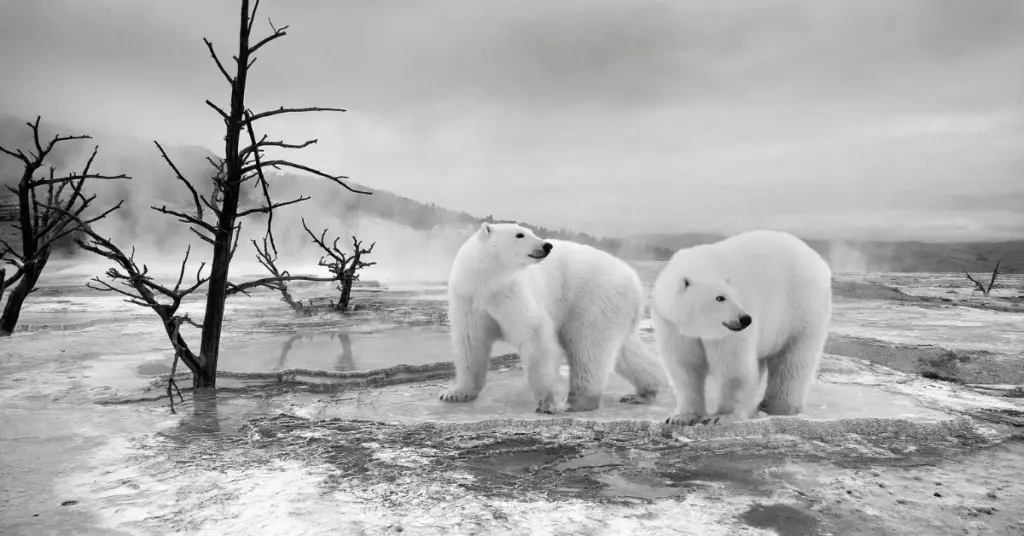Polar bears are adapted to life on the sea ice in the Arctic and depend on it for survival. Sea ice is their primary platform for hunting, mating, and traveling. They use the ice to reach their prey, which are mainly seals, and to rest between hunting trips.
Polar bears are excellent swimmers, but the sea ice allows them to conserve energy and avoid having to swim long distances in cold water. Additionally, the sea ice is also crucial for the survival of their cubs. Female polar bears use snow dens on the sea ice to give birth and nurse their cubs, and the sea ice provides a safe place for them to hunt and feed themselves and their young.
In recent years, the Arctic sea ice has been declining due to climate change, which is having a significant impact on polar bear populations. The loss of sea ice is forcing polar bears to travel long distances to find food, and some are even resorting to scavenging on land or becoming more aggressive toward humans. This is why the preservation of the sea ice is so important for the survival of polar bears.
As the sea ice continues to shrink, polar bears are also facing other challenges that threaten their survival. For example, they may have to compete with other predators for food, such as wolves and foxes, which are moving into the Arctic as the sea ice disappears.
In addition, the changing Arctic environment is also affecting the availability of seals, which are the main food source for polar bears. As the sea ice changes, so does the distribution and abundance of seals, making it more difficult for polar bears to find enough food to survive.
Moreover, the melting of the sea ice and the resulting loss of habitat is causing polar bear populations to decline, making it harder for them to find mates and reproduce. In some areas, the loss of sea ice is causing polar bears to come into conflict with human populations, which can result in negative consequences for both polar bears and people.
To protect polar bears and their Arctic habitat, conservation efforts are needed. These include reducing greenhouse gas emissions to slow down the rate of climate change, and protecting and restoring the sea ice and other habitats critical to the survival of polar bears. The international community is also working to reduce the hunting of polar bears and limit other human activities that may harm them.
By taking action now, we can help ensure that polar bears continue to thrive in the Arctic for generations to come. There are also ongoing research and monitoring programs aimed at better understanding the impact of climate change on polar bear populations and their habitat. These studies provide valuable information on the status of polar bears and help inform conservation efforts.
For example, wildlife biologists are tracking the movement and behavior of polar bears to learn more about how they are adapting to the changing Arctic environment. They are also monitoring the health of polar bear populations, including their body condition, reproductive success, and survival rates.
Another important aspect of the conservation effort is education and outreach. By raising awareness about the challenges facing polar bears and the importance of their habitat, we can inspire people to take action and help protect these magnificent creatures.
In conclusion, polar bears are an important part of the Arctic ecosystem and play a critical role in maintaining its balance. By protecting the sea ice and other habitats critical to their survival, we can help ensure that polar bears continue to thrive for generations to come.
Why bears can’t survive without ice?
Bears, including polar bears, are adapted to life in specific habitats and rely on certain resources to survive. In the case of polar bears, they are specifically adapted to life on the sea ice in the Arctic and depend on it for their survival.
The sea ice provides a platform for polar bears to hunt their main prey, seals, as well as a safe place for them to mate, give birth, and raise their cubs. It also enables them to conserve energy and avoid having to swim long distances in the cold water.
Without the sea ice, polar bears would face significant challenges in finding enough food to survive, as well as safe places to mate and raise their young. The loss of sea ice due to climate change is already having a significant impact on polar bear populations, causing them to decline and putting their survival at risk.
In addition, as the sea ice continues to shrink, polar bears are facing other challenges, such as increased competition for food, declining prey populations, and conflict with human populations. These factors make it even more important to protect the sea ice and other habitats critical to the survival of polar bears.
Polar bears cannot survive without the sea ice because it is a vital component of their habitat and supports all aspects of their life, from hunting to reproduction. By protecting the sea ice, we can help ensure that polar bears continue to thrive in the Arctic for generations to come.

Erzsebet Frey (Eli Frey) is an ecologist and online entrepreneur with a Master of Science in Ecology from the University of Belgrade. Originally from Serbia, she has lived in Sri Lanka since 2017. Eli has worked internationally in countries like Oman, Brazil, Germany, and Sri Lanka. In 2018, she expanded into SEO and blogging, completing courses from UC Davis and Edinburgh. Eli has founded multiple websites focused on biology, ecology, environmental science, sustainable and simple living, and outdoor activities. She enjoys creating nature and simple living videos on YouTube and participates in speleology, diving, and hiking.
🌿 Explore the Wild Side!
Discover eBooks, guides, templates and stylish wildlife-themed T-shirts, notebooks, scrunchies, bandanas, and tote bags. Perfect for nature lovers and wildlife enthusiasts!
Visit My Shop →
